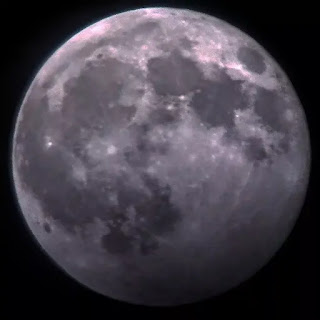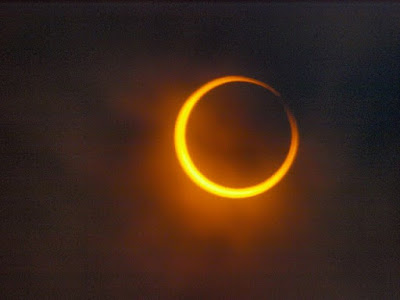Astronomical events to look forward in 2020 - Three eclipses in June & July
Penumbral lunar eclipse, second of 2020 to occur on 5-6 June:
In between the night of 5 and 6 June the second of the four penumbral lunar eclipses of 2020 is expected to occur.
This penumbral lunar eclipse popularly called as 'Strawberry Moon Eclipse'. Since 57 percent of the moon enters Earth’s penumbra, it can be hard to see as the moon will be slightly darken.
The lunar eclipse will be visible in much of Europe, Asia, Australia, Africa, Antarctica, South/East South America, Pacific, Atlantic and Indian Oceans.
What is lunar eclipse?
When Earth comes
between the sun and the moon the lunar eclipse will occur because of
the Earth’s shadow blocks the sun’s light reaching the moon.
Types of lunar eclipses:
- Total lunar eclipse
- Partial lunar eclipse
- Penumbral lunar eclipse
A penumbral lunar eclipse occurs when the moon passes through the outer part of the Earth's shadow (faint).
 | |
|
Timing of penumbral lunar eclipse 5-6 June:
In India, the eclipse will begin from 5 June at 11.15 pm (5.45 pm UTC). It will continue till 6 June at 02.34 am (5 June, 09.04 pm UTC). The maximum eclipse will occur on 6 June, 12:54 am (5 June , 07.24 pm UTC). The total duration of the eclipse is about 3 hours and 18 minutes.
| Event | IST time | UTC time |
| Penumbral Eclipse begins | 5 Jun, 23:15:51 | 5 Jun, 17:45:51 |
| Maximum Eclipse | 6 Jun, 00:54:55 | 5 Jun, 19:24:55 |
| Penumbral Eclipse ends | 6 Jun, 02:34:03 | 5 Jun, 21:04:03 |
If the sky is clear, people will be able to see it completely because of the moon is above the horizon during the penumbral lunar eclipse.
The next two lunar eclipses of 2020 will be on 5 July and 30 November. Since both of them are penumbral lunar eclipses.
Timing of penumbral lunar eclipse 5 July:
In India, the eclipse will begin from 5 July at 08.37 am (03.07 am UTC). It will continue till 5 July at 11.22 am (5 July, 05.52 am UTC). The maximum eclipse will occur on 5 July, 09.59 am (5 July , 04.29 am UTC). The total duration of the eclipse is about 2 hours and 45 minutes.
| Event | IST time | UTC time |
| Penumbral Eclipse begins | 5 Jul, 08:37:23 | 5 Jul, 03:07:23 |
| Maximum Eclipse | 5 Jul, 9:59:51 | 5 Jul, 04:29:51 |
| Penumbral Eclipse ends | 5 Jul, 11:22:21 | 5 Jul, 05:52:21 |
If weather conditions are good, then the lunar eclipse will be visible in South/West Europe, Much of Africa, Much of North America, South America, Antarctica, Pacific, Atlantic, Indian Oceans.
Annual solar eclipse of 2020 to occur on 21 June:
A solar eclipse occurs when the moon passes between the sun and the earth. When this happens, the moon blocks the light of the sun from reaching the earth. The shadow of the moon is projected on the earth.
Types of solar eclipses :
- Total solar eclipse:
Total solar eclipse is only visible from a small part. For the phenomenon to occur, the sun, moon and earth are lined up.
- Partial solar eclipse:
When the sun, moon and earth aren’t lined up exactly.
 |
| Annual_solar_eclipse_Into_the_dark_space |
The solar eclipse of 21 June, is an annular eclipse. This happens when the moon’s apparent diameter is smaller than the Sun’s, blocking most of the Sun light reaching the earth which causes Sun to appear like ring of fire. This time it can be partially viewed form several regions of earth.
Timing of the annual solar eclipse 21 June:
In India, the eclipse will begin from 21 June at 09.15 am (03.45 am UTC). It will continue till 21 June at 03.04 pm (09.34 am UTC). The maximum eclipse will occur on 21 June, 12.10 pm (06.40 am UTC). The total duration of the eclipse is about 5 hours and 49 minutes.
| Event | IST time | UTC time |
| Partial Eclipse begins | 21 Jun, 9:15:58 | 21 Jun, 03:45:58 |
| Full Eclipse begins | 21 Jun, 10:17:45 | 21 Jun, 04:47:45 |
| Maximum Eclipse | 21 Jun, 12:10:04 | 21 Jun, 06:40:04 |
| Full Eclipse ends | 21 Jun, 14:02:17 | 21 Jun, 08:32:17 |
| Partial Eclipse ends | 21 Jun, 15:04:01 | 21 Jun, 09:34:01 |
The eclipse will be visible from parts of Africa, including Central African Republic, Congo and Ethiopia. South of Pakistan and north India and China too will be able to see the eclipse.
The second and last solar eclipse of 2020 which is on December 14. Since it is a total solar eclipse.
Source: timeanddate
For more information click here and for updates please follow my site,
Thank you.
Nice one!!
ReplyDeletethank you
DeleteSuperb
ReplyDeletethank you
DeleteNice
ReplyDeletethank you
DeleteGood information 👌
ReplyDelete